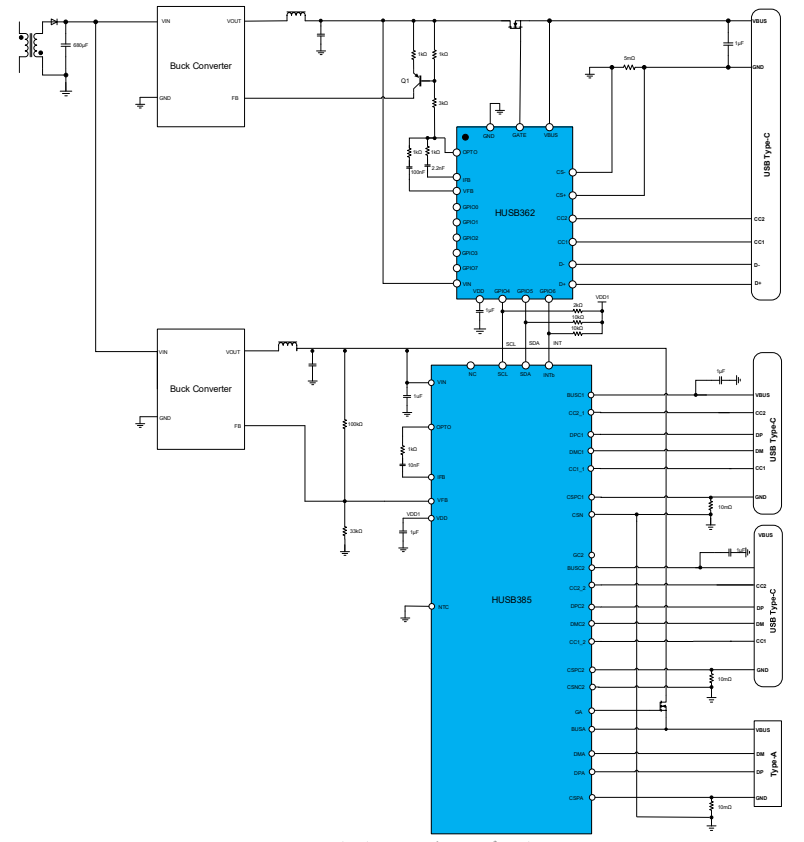Mutiple USB Charging Ports Controller with I2C Interface
6 20, 2025
The HUSB385 is a high performance, high integration 3-Ports controller (2C1A or 2A1C). When a single port is attached, the controller enables fast charging protocols such as USB PD or HVDCP. However, when 2 or more ports are connected simultaneously, it provides only a 5 V output.

Figure 1: HUSB385 QFN-32L Package and 2C1A Demo Drawing
FEATURES
USB Type-C 2.1 and USB PD 3.1 Compliant
– Support 5 V, 9 V, 12 V, 15 V and 20 V FPDOs
– Support 2 Programmable APDOs
Support BC1.2 DCP and HVDCP Protocols
– BC 1.2 DCP Mode
– Apple 5 V 2.4 A Mode
– QC 2.0/3.0/QC 3.0+ Class A or Class B
– AFC, FCP and LVSCP/HVSCP
– PE 1.1+ and 2.0
– UFCS
Support 3-ports Application (2C1A or 2A1C)
As Low As 5 mA Light Load Detection
Integrated Two Low Rdson N-MOSFETs
Support Constant Voltage Loop(CV) and Constant Current Loop(CC) Operation
Support I2C Function
Multiple Cable Compensation Options
Integrated OVP, UVP, UVLO, OCP, FOCP, CC/DPDM OVP, TSD and OTP Protections
QFN-32L (4 mm x 4 mm) Package
±6 kV HBM ESD Rating for USB IO Pins
Minimalist Design:
The HUSB385 maintains robust protocol compatibility and safety mechanisms while integrating two low-Rdson N-MOSFETs internally. This reduces external component count, simplifies PCB complexity, and enhances overall system stability and reliability.

Figure 2: HUSB385 2C1A Typical Application Circuit Diagram
Triple Independent Power Reporting for Display:
The HUSB385 supports I²C communication mode. In I²C mode, the host can read real-time operational status, handshake protocols, output voltage, output current, and three-channel independent current data via the I²C bus for display purposes.
Unlimited Dynamic Power Broadcast:
In I²C mode, based on the acquired charging voltage, current, and active charging protocol, the host can dynamically adjust the HUSB385's power, voltage, and protocol limits through the I²C bus to achieve intelligent power allocation.
PD3.1 EPR High-Performance Solution:
By combining the HUSB385 with Hynetek's high-performance PD protocol chip HUSB362 (which supports PD3.1 EPR and features an integrated MCU), a dual-port independent fast charging solution with dynamic power allocation can be implemented. This solution supports I²C online control, real-time reporting of operational status/voltage/current data, and dynamic power distribution.
Taking a 2-channel Buck application (HUSB385 + HUSB362) as an example:
The solution enables flexible multi-step power reduction via I²C
Supports 65W total output with configurable dual USB-C port power combinations (X+Y):
15W+50W, 20W+45W, 30W+35W, 25W+40W, etc.
Figure 3: Dual-Channel Buck Application with HUSB385+HUSB362



